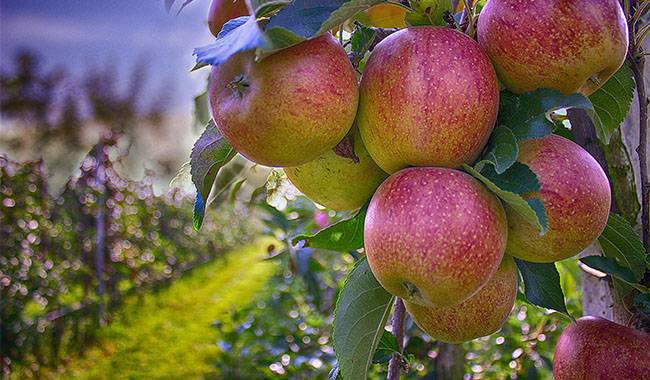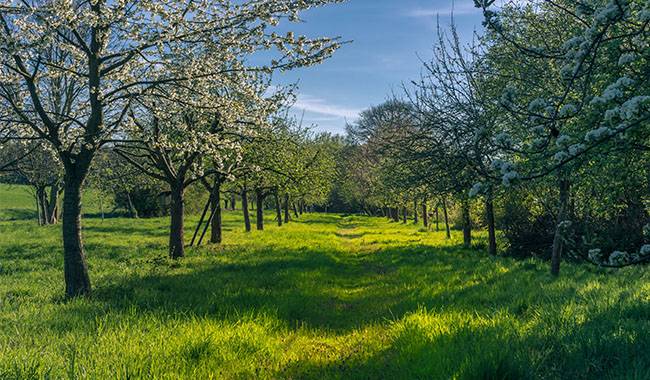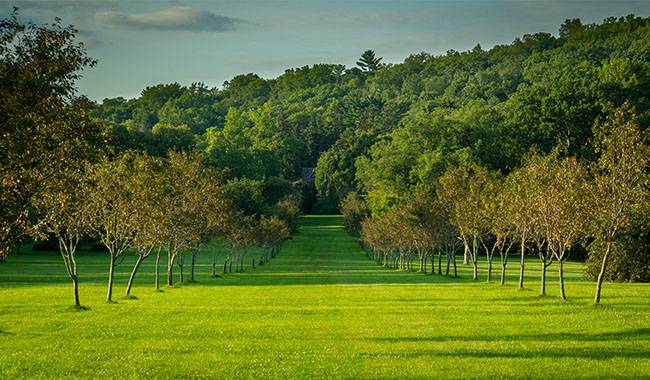
Planning a fruit and berry orchard is responsible for determining the future availability of delicious and varied fruits and berries for your family. Therefore, you should (as the saying goes) take your time in planning your plot, and this article will describe how to layout fruit tree orchard design.
PREPARATION OF THE WORK
When planning the site, it is important to provide an open, sunny location with a high water table. It should not be planted in a valley where cold air and water currents tend to push it down during spring floods. After an external inspection of the garden allotment, identify and record a list of preparation steps in your diary.
- Remove old stumps, wild shrubs, rocks, and other debris from the area.
- Till the area deeply or dig over it in layers by turning it over.
- Water the area to stir up weeds. After the seedlings have germinated, plow deeply and level the land.
- At the same time, take the soil to the nearest chemist to have it analyzed for its physical condition and type and its chemical composition. This is necessary for the subsequent maintenance of the garden: fertilization, watering, and other tillage measures.
- Based on the analysis results (recommendations), apply the recommended doses of fertilizers and other soil improvement components at the last fall plowing. Fertilizer application to an area is not recommended in the absence of these data. It is better to apply fertilizers and other components directly to the planting hole (mineral fertilizers, humus or bio-humus, quicklime, biological pest preparations).
PLANNING THE LAYOUT OF FRUIT TREES AND SHRUBS
On a separate sheet of paper from your garden diary, draw the garden layout. The garden can be in front, to the side, or behind the house, but the trees and shrubs should be positioned in a north-south direction for better light and with three areas. These can be arranged one in front of the other or divided into three separate areas located at different ends of the entire dacha area.
- In the case of joint zoning, the first zone contains a vegetable garden whose plants do not shade the crops in the second zone and get their share of sunlight in the morning.
- In the second zone, it is best to place berry bushes. They should reach 5 feet (1.5 meters) high. The early morning shade of the bushes will not harm the plants in the third zone.
- In the third zone, the actual orchard will be planted. It should be kept 8-10 feet (2.5-3 m) away from neighbors so as not to overshadow their plots.
On the page of the garden diary, please write down the names and brief descriptions of the fruit and berry crops and indicate their location in the plot area under the numbers in the diagram.
THE LAYOUT OF BERRY BEDS
When laying out your berry garden, take the characteristics of the plants directly into account. For example, blackcurrants grow well surrounded by other neighbors, but buckthorn and lingonberry are rather unfriendly to their neighbors. Therefore, they should be planted separately. Buckthorn can be used as a hedge, laurel roses, and hawthorn can be used as landscape decoration in rest areas. Planted separately on a manicured lawn, they look lovely.
Some owners think that berry trees are generally better arranged along the plot boundaries. In this case, part of the land is cleared for other crops or areas (recreation, sports, etc.). This planning is appropriate if the plot is not enclosed by a green fence or if the berry bushes themselves can serve this purpose with their own characteristics (thorny, lush, etc.).
The density of the berry bushes is very important. It is a natural regulator of optimal plant development, disease resistance, and yield formation.
- Raspberries are planted in dense rows 20 inches (0.5 m) apart and 3-5 feet (1-1.5 m) between rows. As they grow, raspberries occupy the space between rows, and the former space between rows is cleared of raspberries to make a temporary pathway. By pruning the shoots, the crop is switched out and returned to its original position after 2-4 years.
- Yarrow, black currant, and golden currant were planted at least 5 feet (1.5 m) apart and red currant at 3 foot (1 m) intervals. Large bushes can shade each other, and the thorns of individual gooseberry varieties can even restrict access to the berries. Honeysuckle and iris are planted at 3-5 foot (1-1.5 m) intervals (or even more densely) when used as hedges and up to 6.5 feet (2 m) apart in berry beds.
The number of different berry bushes is very important. Think ahead and plan the number of each species and variety so you can provide fresh berries for your family and make berry preserves for the winter. A family of 4-5 people will need 20 raspberry bushes, 3-4 bushes each of various currants and gooseberries, brambles, honeysuckle, and willows. Leave some room for new exotic species that will come into your line of sight over time. A well-planned berry orchard grows and fruits normally for 7 to 12 years, then gradually rejuvenates or moves the bushes to another location.
DIVIDE THE ORCHARD
On the next blank page of your garden journal, draw the layout of the fruit crops. Allocate approximately 43 square feet of floor space for one tree for each crop. Do not allow the plantings to overgrow. Trees can overgrow and begin to interfere with or even overpower each other. Planting holes should be spaced 13-15 feet (4-4.5 m) apart in the row. Allow at least 8-10 feet (2.5-3 m) between rows. Pay attention to the type of crop. For example, most farms are now switching to colonial apple and pear trees, which are the main garden crops of Dacha Agriculture. These species are much smaller and produce almost as much as the taller crops. Columnar plants are easier to care for, are resistant to disease, and suffer less damage from frost.
For an average family, 1-2 trees of each species are sufficient. Early, mid and late varieties should be present in the garden to have fresh fruit throughout the warm season and still have processed fruit ready for winter. In the orchard crop, 2 cherries (early and late) are enough. Plant 2 cherries instead of the intermediate ones. They will form a crop after the early cherries. You need 1 quince (on which you can later graft another variety or other varieties), 2-3 plums.
1-2 frost-resistant varieties of apricots will be enough. 2-3 apple trees, which can be turned into 6-8 varieties of different maturity stages by grafting over time. Don’t forget to leave room for exotic species. Be sure to replant walnut trees separately. There is hardly anything growing under the canopy of this crop. If you like hazelnut, put it in the front row, so the taller trees don’t deprive it of sunlight with their shade. 11-12 fruit trees will eventually grow into all 18-20 varieties.
To ensure that the garden lasts long and is disease-free, it is important to use the varieties that have been released. They are more resistant to diseases, pests, weather changes and have a longer flowering and fruiting time. You can find varieties for your area in catalogs and other literature, up to the zone and their characteristics. When buying seedlings, be sure to consult with an expert. Remember! A garden grown with inferior seedlings will add work and care, but the yield and quality of the fruit will not satisfy you.
COMMON METHODS OF PLANTING A GARDEN

Start planting your garden in the fall, which means digging planting pits according to your plan and preparing a fertilizer mixture near each one as needed depending on soil conditions.
Preparing planting holes
In the fall, you can only prepare a planting hole of the approximate size, as the final version will be determined by the size of the root system, depending on the age of the seedlings purchased. For 2-year-old seedlings, the size of the planting hole is tentatively set at about 23×23 inches (60×60 cm) and can be enlarged to 27-30 inches (70×80 cm) for 3-year-old seedlings to be determined after the seedlings are planted in the hole.
Prepare potting soil mixture
Mix topsoil near each hole with humus and peat. In spring, before sowing seedlings, add one cup each of wood ash, quicklime, and 200 g of nitrocellulose to the mixture. Mix well.
Purchase and preparation of seedlings
Planting seedlings is best done in the spring. During the growing season, seedlings will become stronger, and the root system will strengthen. Then, during the warm spring-summer-autumn period, young trees will adapt to their new habitat.
Do not rush to buy saplings from individual sellers you are unfamiliar with, especially on the way to the cottage. It is better to buy saplings from a farm or nursery. Here you can be more sure to buy the ideal release variety for the fruit or berry crop you want.
Examine the selected seedlings carefully. If you find dry roots, bent trunks, cracked bark, or gums, refuse to buy them. Remember! No amount of seller’s guarantee can recover lost time.
Rules for planting young seedlings
Soak seedlings in a rooting agent or other growth promoters 1-2 days before planting. Prepare a container with clay putty containing “Pseudomonas fluorescent bacteria” biopharmaceutical. Other bio fungicides suitable for mixing in the tank can be used.
About 2-3 weeks before sowing seedlings, fill some potting soil cones into the holes. During this week, the cones will settle down, and the planted seedlings will be correctly positioned in the holes. Soak the prepared seedlings in potting soil, insert them into the hole, lay the roots on the cones, so they do not break upwards and fill 2/3 of the hole with potting soil. Pour in a bucket of water. Once it is absorbed, fill it with the rest of the potting soil or bonsai soil. Hammer the stake to secure the sapling to the stand in a figure-of-eight pattern. Loose saplings will sway in the wind and tear out the fine roots that ensure the connection between plant and soil.
IMPORTANT DETAILS FOR PLANTING
When planting, make sure that the root neck is positioned at the correct depth. If it is too deep, the tree may shrivel up for no apparent reason within 5 to 10 years (especially on thick soils). On light sandy loam soils (especially in the south), it is best to “hide” the root neck portion from the upper dry layer by burying it 3 to 4 inches (8 to 10 cm) in the soil. For seedlings that form adventitious roots or shoots (figs, currants, plums, apple trees), immersion does not affect the normal development of the tree. Seedlings of these crops rapidly re-establish their root system, more often than not on insufficiently moist soil.
In rootstock seedlings, the root neck should be at the level of the planting hole or 0.8-1.2 inches (2-3 cm) higher (no more). In grafted seedlings, the grafting point should be 2-3 inches (5-8 cm) above the rootstock. Beginners often confuse rootstocks and grafting by planting seedlings to the grafting point. In this case, the rootstock will be deeply embedded in the soil, and the tree will die prematurely.
If you have correctly identified the root neck and planted the seedling 1.5-2 inches (4-5 cm) above the soil, then the tree is correctly planted.
Consolidate the soil around the planting site. Make a roller 2-2.7 inches (5-7 cm) high at a radius of 12-20 inches (30-50 cm) from the tree’s trunk and pour 2-3 buckets of water. Together with the absorbed water, the seedlings will be sucked into the soil. Ensure the root neck stays 0.8-1.2 inches (2-3 cm) above the soil. If necessary, add soil after watering and cover with a small layer of fine mulch (peat or humus, sawdust). If live seedlings are purchased and planted correctly, your garden will grow its first shoots in 2-3 weeks.

HOW TO IDENTIFY THE ROOT CANAL
- For young seedlings, wipe the bottom of the trunk and the beginning of the roots with a damp cloth. The roots can be identified as a transition from green (trunk) to light brown (root area).
- For older seedlings (3-4 years old), wipe the lower part of the trunk with a damp rag and once the wet area is dry, carefully scrape off the bark with a knife where the trunk extends slightly to the roots. If the color of the lower layer of the young cortex at the expansion is green, it is the stem, and if it is yellowish, it is the root zone. The area where one color transitions to the other are the root neck.
- In some young seedlings, the upper lateral roots are clearly visible where they leave the trunk. This is the root ball. The place where the roots are found must be kept above the level of the planting hole.
WHAT NOT TO DO WHEN PLANTING SEEDLINGS
- Do not use semi-rotten manure for planting, but only humus mixed with soil.
- Do not water the seedlings with small amounts of water frequently. This will only dry out the soil in the planting hole.
- You should not water the seedlings with cold water (tap water).
- Do not fertilize the plants for the first year after planting, especially with nitrogen fertilizer.
- Do not cover the root zone with a large layer of mulch after planting. In case of heavy rains, the water accumulated in the mulch can cause the young bark to dry out and kill the plant. A thick layer of mulch should be placed in the fall to protect the soil from frost damage and prevent young seedlings from dying due to low temperatures.
WHAT DO I NEED TO DO WHEN PLANTING YOUNG SEEDLINGS?
- Brush the seedlings with chalk and clay solution and add biological agents for pest and disease control or copper alum solution.
- Insulate the trunk with several layers of burlap, non-woven mulch, spunbond, paper, and other materials.
- Protect the trunk from rabbits and other rodents by burying the latter 2-4 inches (5-10 cm) into the soil with wire mesh.
- Tamp down the snow around the trunk after heavy enough snowfall to protect it from rodents.
More Related Information About Gardening Tips








beautiful information and very informative.
Thank you
Wow lots of good info. But could you include drawn sample desgins? It would help to fully understand your concepts